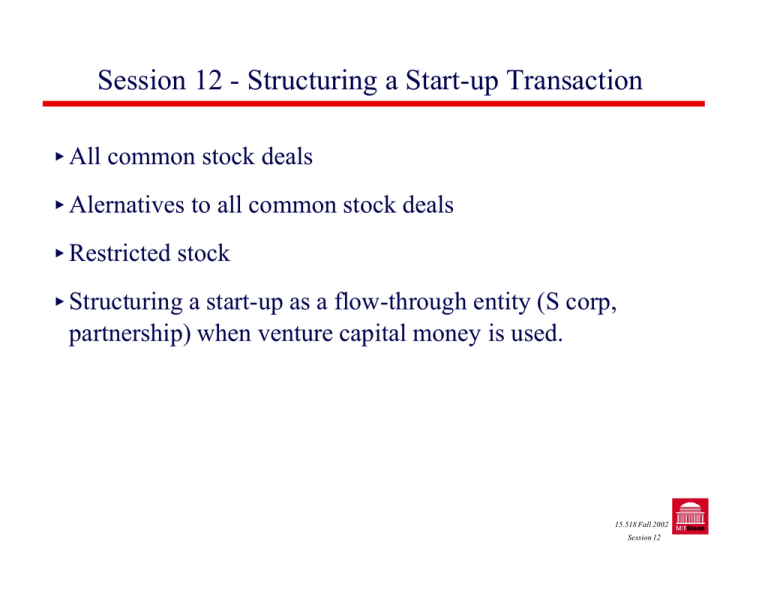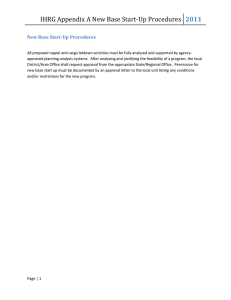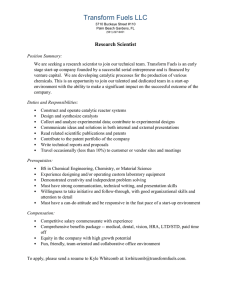Document 13620767
advertisement

Session 12 - Structuring a Start-up Transaction � All common stock deals � Alernatives to all common stock deals � Restricted stock � Structuring a start-up as a flow-through entity (S corp, partnership) when venture capital money is used. 15.518 Fall 2002 Session 12 Structuring a Start-up Transaction � Basic Setup: • Your team (TEAM) has just won the 50K Competition • A local venture fund principal impressed by your product’s potential, approaches you with an offer to invest $10 million in your concept. • You make an appointment for the following week to go over your proposed structure for the new company. 15.518 Fall 2002 Session 12 Structuring a Start-up Transaction TEAM VC Ideas/Expertise $$$$$ Start-up 15.518 Fall 2002 Session 12 Structuring a Start-up Transaction � TEAM Proposal: All Common Stock VC Amount invested $10 million Stock received 49,000 shares TEAM Ideas & Expertise 51,000 shares � Does the VC fund accept your proposal? � If they do, should you be pleased with your negotiated proposal? 15.518 Fall 2002 Session 12 Structuring a Start-up Transaction � VC funds generally reject 100% common-stock structures for a new start-up. � What happens if STARTUP fails? • Example: After $5 million is spent, STARTUP concludes its ideas are technologically or commercially impractical # VC would prefer to recover the entire remaining $5 million (not a 49% share) 15.518 Fall 2002 Session 12 Structuring a Start-up Transaction � What happens if STARTUP succeeds? • Example: STARTUP is a big hit and is sold to a competitor 12 months later for $20 million # VC’s 49% share of the company would net only $9.8 million ($200,000 less than their initial investment) # VC would prefer to share the “profits” only A return of its $10 million dollar investment A 49% share of the “$10 million” profit 15.518 Fall 2002 Session 12 Structuring a Start-up Transaction � Other Considerations: • VC may want a portion of investment in the form of debt => a tax-deductible interest expense for STARTUP • VC may want TEAM to invest cash in the project => with nothing to loose, TEAM members may walk away too easily 15.518 Fall 2002 Session 12 Structuring a Start-up Transaction � Should you be pleased? � How much cash do you have in the bank? • Code Section 83(a): An individual contributing present or future services to a business enterprise in exchange for equity generally recognizes income upon receipt of the equity. # TEAM members may IMMEDIATELY owe tax on $5.1 million of ordinary income (at today’s top statutory rates we’re talking about somewhere in the neighborhood of at least $2 million). IRS may even argued that the company is worth $20.4 million based on VC’s willingness to pay $10 million for 49%. 15.518 Fall 2002 Session 12 Structuring a Start-up Transaction � Problems: • Taxed at higher rate: Top ordinary income rates are double the long term capital gains rate • Loss of deferral: Must pay taxes NOW � STARTUP does get a deduction for the amount TEAM recognizes as compensation but who needs deductions with no income? 15.518 Fall 2002 Session 12 Structuring a Start-up Transaction - VC Proposal VC Preferred stock $9,500,000 Common Stock $350,000 (70%) Stock shares received 70,000 TEAM Total invested $150,000 $9,850,000 150,000 (30%) 30,000 15.518 Fall 2002 Session 12 Characteristics of Preferred Stock: 1. Liquidation Preference: Preferred stock holders have the right to receive purchase price plus unpaid dividends before any assets are distributed to common stockholders 2. Conversion Rights: Preferred stock issued in venture capital deals is convertible at the holder’s option or automatically if a company goes public 3. Voting Rights: Preferred stock holders have the right to vote with the common stock holders, in proportion to their conversion ratios (e.g., if the conversion ratio is 1-to-1, then the VC fund receives 1 vote for each share of preferred stock) 4. Redemption Provisions: Allow VC to recover its investment plus a profit if a company fails to meet expectations. Some provisions can be used by a company to force conversion to common stock. 5. Anti-dilution Provisions: convertible preferred stock generally contains provisions protecting against dilution from stock splits / stock dividends 6. Dividend Preference: Preferred stock dividends must be paid before common stock dividends (may be cumulative). 15.518 Fall 2002 Session 12 Structuring a Start-up Transaction � What are the benefits achieved with the new proposed structure? • VC has a senior claim to the first $9.5 million (protection against STARTUP failure) • STARTUP’s upside is split between VC and TEAM based on returns after VC’s initial investment is “recouped” • TEAM has no compensation issues under Section 83(a) • TEAM has personal wealth at risk (less likely to walk away) 15.518 Fall 2002 Session 12 Structuring a Start-up Transaction � Vesting: Founders are generally restricted from selling their initial equity for a period of time. • A typical scenario may provide that 25 percent of the shares vest at the end of the first year of employment, with 2 percent of the shares vesting monthly thereafter. • Vesting arrangements generally accelerate the founders' vesting if the company is acquired. � Why Have Vesting? • Protection for founders => All original members of a founding team may not remain with the company. If this happens in a firm without vesting, the exfounders who keep their stock can “free-ride” on the efforts of those who continue to build the company. • Protection for VC => Increases commitment of founders to the company. Also forces the founders to “earn” the value contributed by the VC provided financing. 15.518 Fall 2002 Session 12 Structuring a Start-up Transaction � Tax Implications of Restricted Stock • Shares which are transferred subject to forfeiture and transferability restrictions (vesting) are normally taxed to the employee when those restrictions lapse • Tax is based on the difference between the FMV of the stock at the point in time when restrictions are lifted and what the employee paid for the stock # TEAM will owe tax on “ordinary income” NOT a long term capital gain 15.518 Fall 2002 Session 12 Structuring a Start-up Transaction - Section 83(b) Election � Section 83 (b) allows an employee to elect to accelerate tax payment to the time when shares are received rather than the time vesting occurs. If this election is made, the compensation element is closed at the time of receipt rather than vesting. � In our example, TEAM's tax liability should be zero – the founders paid FMV for their stock $5/share => the same price paid by VC 15.518 Fall 2002 Session 12 Structuring a Start-up Transaction - Section 83(b) Election � Election must be made within 30 days after TEAM's purchase of stock � Election must be in writing and must be filed with the IRS office at which the employee regularly files his tax returns � The written statement must also be attached to the employee's income tax return for the year of the transfer � The employee must send a copy of the election to the employer � The election is irrevocable 15.518 Fall 2002 Session 12 Structuring a Start-up Transaction - Section 83(b) Election � Section 83(b) Election Statement • The taxpayer's name, address, and identification number; • A description of the property which is the subject of the election; • The date of transfer; • The nature of restrictions attached to the property; • The FMV of the property; • The amount paid (if any) for the property; and • A statement that copies of the election have been filed with the employer. 15.518 Fall 2002 Session 12 Structuring a Start-up Transaction � What about structuring STARTUP as a flow-through entity (S Corporation, Partnership, or LLC)? • Eliminates Double taxation • Allows for the pass-through of losses as they occur • Items of income or loss retain their character (e.g., capital gains) 15.518 Fall 2002 Session 12 Structuring a Start-up Transaction � An “S” Corporation is generally NOT a feasible option: • Shareholders of an S corporation can’t be a C corporation, partnership, or LLC � Alternative: VC can supply most of STARTUP’s funding in the form of “debt” with a conversion feature • Problem: If debt to equity ratio is unreasonable, VC debt can be re-characterized as equity 15.518 Fall 2002 Session 12 Structuring a Start-up Transaction � A partnership is also generally NOT a feasible option: • General partners do NOT have limited liability protection. � Alternative: STARTUP can be structured as a limited partnership with a corporate general partner • Problem: VC’s exercise of decision making authority could be viewed as taking part in the control of STARTUP’s business destroying LP status 15.518 Fall 2002 Session 12 Structuring a Start-up Transaction � What about a limited liability company (LLC)? • LLC statutes adopted in the various states are not uniform (limited liability may not be a given in a “foreign state”=> unlikely) • LLC is not an optimal structure for a company that intends to go public shortly after its founding • LLCs may become more common for owners that want passthrough treatment and don’t intend to go public in the near future 15.518 Fall 2002 Session 12



